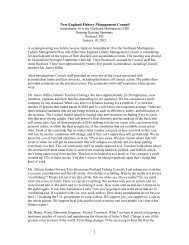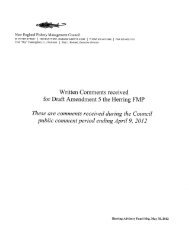Correspondence/Amendment 5 Comments - New England Fishery ...
Correspondence/Amendment 5 Comments - New England Fishery ...
Correspondence/Amendment 5 Comments - New England Fishery ...
Create successful ePaper yourself
Turn your PDF publications into a flip-book with our unique Google optimized e-Paper software.
Ztl<br />
ãt<br />
,W<br />
ffi<br />
:::.tr.a.<br />
P**<br />
þæru<br />
õ ¡zn<br />
È<br />
jrrH<br />
¿14 N<br />
I<br />
$æru<br />
!<br />
I ¿zN<br />
I<br />
4lN<br />
2000-2003 2004-2007<br />
70w 68W 66W 70w ô8w 66w<br />
I'*:<br />
[.i<br />
Fig.2. Comparison between the periods 2000-2003 and 20011-2007 of (A and 8) larval herring abundance during October and November from ichthyoplankton<br />
surveys and (C and D) age 1+ haddock abundance from a September-October Northeast Fisheries Science Center bottom trawl survey. Three<br />
different areas are denoted on the maps and labeled in B: Georges Bank (cB), the Gulf of Maine (GOM), and western Nova Scotia (WNS). Currently, the GOM<br />
andG8spawningcomponent5ofherringaremanagedandassessedjointlyandseparatelyfromtheWN5Component.DuetolarValtransport,larvalherring><br />
abundance indicates only a general region of egg hatching. The spatial distribut¡on of herring spawning across the region is not currently resolved by any t<br />
survey, preventing analyses of the spatial overlap between egg production and haddock predation intens¡ty.<br />
dù<br />
and relatively stable, yet the model predicted continued declines.<br />
The decline in the composite index of herring abundance after<br />
2004 provides particularly good support for the importance of<br />
egg predation by haddock, as it coincided with historically low<br />
herring fishing mortality. \rye further evaluated a seeming contradiction<br />
in the population model: the occurrence of high herring<br />
population levels after 1964, the year with the highest index<br />
of haddock predation intensity since L93L (SI Text). The absence<br />
of herring spawning stock biomass estimates before 1967 limited<br />
the analytical approaches that could be used to evaluate this<br />
issue. For this reason we ran the population model forward from<br />
1931, using estimated herring landings and haddock predation<br />
intensity. This analysis indicated that the mid-1960s peak in<br />
haddock predation intensity was too short-lived (due to intense<br />
fishing of haddock) to drive the herring population to a low<br />
stable equilibrium (Fig. S4).<br />
The population model predicts substantial interannual variability<br />
in the maximum level of fishing mortality that the herring<br />
'6 Ê!'<br />
Ë .-z.o<br />
8I r.s<br />
aEE<br />
tta 9õ 1.0<br />
õ9<br />
Ë-o.u<br />
tt<br />
tt ú<br />
! 1000 2000 1000 2000<br />
o r"^-^.. I ël- -.¡<br />
l*<br />
i:'t<br />
population can endure without trending toward a lower equilibrium<br />
(Fig. 4D). We term this the "critical fishing mortality rate."<br />
The critical fishing mortality rate of zero from 1976 to 1983 and<br />
from 2004 to 2005 indicates that egg predation by haddock was<br />
sufficiently intense in those years to drive the herring population<br />
toward the lower equilibrium regardless of fishing pressure; in<br />
other words, even a complete moratorium on fishing during this<br />
period could not prevent a major population decline nor lead to<br />
a population recovery. For the remainder of years, critical fishing<br />
mortality rates above zero indicate that the population could<br />
tolerate some level of fishing and still trend toward the upper<br />
equilibrium. Actual fishing mortality rates exceeded the critical<br />
rates before 1985 and equaled them during the period 2000-2003.<br />
For the latter period, fishing mortality rates were at historically<br />
low levels and were much less than a single-species model predicted<br />
would lead to a maximum sustainable yield; yet the population<br />
model incorporating egg predation indicated that these<br />
low levels offishing could still cause a severe population decline.<br />
1000 2000<br />
Horrlng spawnlng stock bioma¡¡ (1000 mt)<br />
F¡9. 3. Results of the herring population model incorporating egg predation by haddock. Herring lishing mortal¡ty rates (F) were varied w¡th¡n the model<br />
w¡th the results shown Íor (A) F = 0.0, (8) F= 0.1, and (C) F= 0.4. The predicted rat¡o of recruitment to recruitment at equil¡brium (R:R"0,,"0.'u.¡ provides<br />
a measure of herring population growth rates. Values < 1 (in red; left arrows) indicate a declining population. Values >1 (in blue; right arrows) indicate an<br />
increasing population. The model predicts an upper stable-equilibrium herring population level (black), an intermed¡ate unstable-equ¡librium population<br />
level (gray), and a lower stable-equilibrium level (yellow). With increasing fishing mortality there ¡s a decline in the upper stable-equilibrium population level<br />
of herring as well as the minimum level of haddock predation intensity that leads only to a lower equilibrium herring population level. The lower stable<br />
equilibrium is predicted to be very low (but greater than 0) due to minimal prey switching estimated in the egg predation model (5/ Iext).<br />
íí{ç,<br />
,.. Ll<br />
Richardson et al. PNAS Early Edition | 3 of 6<br />
I'¡<br />
ff-







